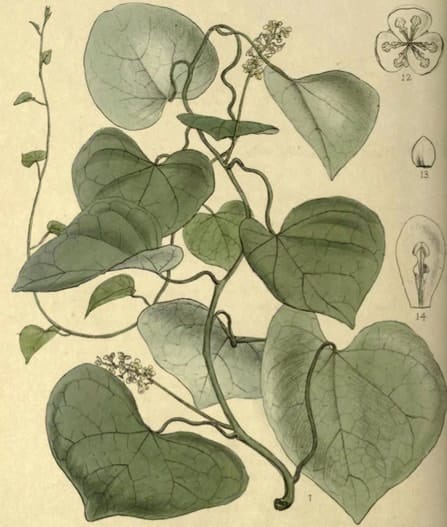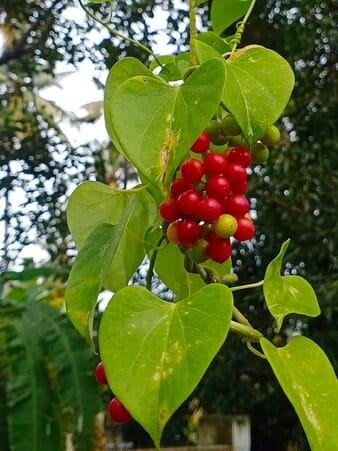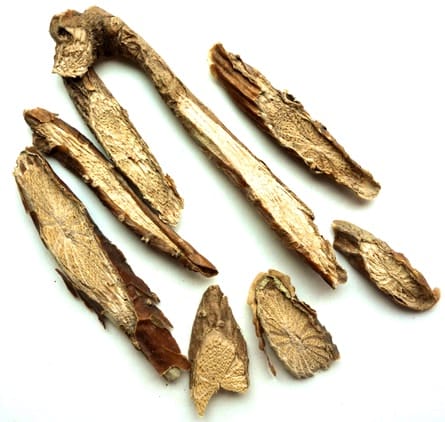Tinospora, GuduchiGuduchi (Ayurveda)Gilo (Unani) Zet al-Roomi, Zet al-Buta (Arabic) Sle Tres སླེ་ཏྲེས (Tibetan) Kuan Jin Teng (TCM) |

|
 Tinospora cordifolia
Tinospora cordifolia Tinospora cordifolia with fruit
Tinospora cordifolia with fruit(Photo by Sanu N) (Wikimedia)
 Tinospora cordifolia stems as used in Tibetan Medicine.
Tinospora cordifolia stems as used in Tibetan Medicine.(Adam, 2016)
 Members CLICK HERE for the PRO VERSION
Members CLICK HERE for the PRO VERSIONBotanical name:
Tinospora cordifolia (syn. Menispermum cordifolium, Cocculus cordifolius)
Related species used similarly include T. crispa, T. malabarica (syn. T. sinensis, T. tormentosa) which are regarded as weaker.
Parts used:
Stem (Caulis) is most used; Stem and Root; sometimes the whole plant
Temperature & Taste:
Neutral/slightly Warm, Bitter
Classifications:
3H. LACTAGOGUE
3Q. ANTHELMINTIC
S. Medicines for Worms and Parasites
TCM:
D. Clear Wind and Damp
Uses:
1. Clears Heat and Damp:
-Diarrhea, Dysentery, Gonorrhea
-Epigastric pain from Heat
-Jaundice
2. Clears Wind and Heat, Resists Toxin (TCM, Ayurveda, Tibetan):
-Fever, Intermittent Fever, Epidemic Fevers
-Sore Throat, Diphtheria
-Boils, Carbuncles
-skin diseases including Leprosy
-Venomous Bites including the bites of poisonous Insects and Snake bite
3. Clear Wind and Damp, Reduces Pain (Ayurveda, Tibetan Medicine, TCM):
-regarded as specific for Gout
-Arthritis and Rheumatoid Arthritis
4. Clears Hot Phlegm, Stops Cough:
-heat-type Cough, Bronchitis
-Tuberculosis
5. Benefits Qi and Yin:
–Rasayana: regarded as strengthening in Ayurveda; good for general debility, especially after Fever and chronic Illness
-premature ageing caused by depletion of 7 Body constituents (Tibetan Medicine)
-regarded as promoting Longevity.
-Diabetes
Dose:
Powder: 2–6 grams
Correctives:
… available in PRO version
Substitutes:
… available in PRO version
Comment:
… available in PRO version

Main Combinations:
1. Gout, Arthritis and Rheumatoid Arthritis:
i. Tinospora has been combined … available in PRO version
ii. Tinospora with … available in PRO version
iii. Tincospora and … available in PRO version
iv. clinical trials used a decoction of Tinospora with … available in PRO version
v. Tinospora with … available in PRO version
vi. Rheumatoid Arthritis, Tinospora with … available in PRO version
vii, Tinospora with … available in PRO version
viii. Tinospora with … available in PRO version
2. Hepatitis, Liver diseases:
i. Tinospora with … available in PRO version
ii. Tinospora with … available in PRO version
iii. Tinospora with … available in PRO version
3. Cough, Asthma, Fever, Tinospora with … available in PRO version
4. Clear Heat and Bile:
i. Tinospora with … available in PRO version
5. Fever:
i. Tinospora with … available in PRO version
ii. from Wind and Heat, Tinospora, … available in PRO version
iii. Chronic Fever, Tinospora with … available in PRO version
iv. Compelx Fever from mixed Humors, Tinospora with … available in PRO version
6. For Epidemic diseases and heat and toxin of the Blood including Small Pox, … available in PRO version
7. Skin diseases:
i. Eczema, Inflammatory skin conditions, Tinospora with … available in PRO version
ii. inflammatory skin diseases, Tinospora, with … available in PRO version
iii. Chronic skin diseases including Leprosy, Tinospora with … available in PRO version
iv. obstinate skin diseases, Tinospoa with … available in PRO version
v. Tinospora, with … available in PRO version
8. Acne:
i. Tinospora, … available in PRO version
ii. Tinospora with … available in PRO version
9. Toxic Swellings, Tinospora with … available in PRO version
10. Cold and Weak Digestion, Tinospora with … available in PRO version
11. Diarrhea with Fever, Tinospora with … available in PRO version
12. Gastric reflux, Hyperacidity from Heat/Bile, … available in PRO version
13. Immunodeficiency:
i. Tinospora with … available in PRO version
ii. Tinospora with … available in PRO version
14. Insomnia, Tinospora with … available in PRO version
15. Diabetes:
i. Tinospora, … available in PRO version
ii. Tinospora with … available in PRO version
iii. Tinospora, … available in PRO version
16. Impotence:
i. Tinospora with … available in PRO version
ii. Tinospora with … available in PRO version
17. Seminal debility. Tinospora with … available in PRO version
18. Female Debility, Tinospora with … available in PRO version
19. Hemorrhoids, Tinospora with … available in PRO version
Major Formulas:
Nagaradi Kvatha Churna
Aloeswood 15 (Tibetan Medicine)
Aloeswood 31 (Tibetan Medicine)
Aloeswood 35 (Tibetan Medicine)
Asafetida 25 (Shin kun nyer lnga) (Tibetan Medicine)
Catechu 25 (Seng ldeng 25) (Tibetan Medicine)
Emblic 25 (Skyu ru nyer lnga) (Tibetan Medicine)
Frankincense 10 (Spos dkar 10) (Tibetan Medicine)
Garuda 8 (Khyung lnga mchu sder can) (Tibetan Medicine)
Gentiana algida 15 (Spang rgyan dkar po 15) (Tibetan Medicine)
Nux Vomica 13 (Ko byi bcu gsum) (Tibetan Medicine)
Principle 25 (Gtso bo nyer lnga) (Tibetan Medicine)
Cautions:
1. Not used during Pregnancy or Postpartum
Main Preparations used:
-
Extra Info
-
History
|
‘A well-known medicinal plant, long in use in Hindu medicine, and considered to be cold and dry, or, according to Arabic and Persian writers, hot and dry in the first degree. In native practise it is much valued as an antiperiodic in fevers, and as a tonic and alterative ; it is also credited with aphrodisiac properties. The fresh plant is said to be more efficient than the dry, it is taken with milk in rheumatism, acidity of the urine and dyspepsia. The juice with Pakhanbed and honey is given in Gonorrhoea, and is an ingredient in Panshtiks given in Phthisis. The stem, if placed upon a bush in the open air, will retain its vitality through the hot season, and when the rains commence, put forth leaves and long whipcord like roots, which soon reach the ground. Guloe is very common on the Western Coast, and may always be obtained in the green state; the dry stem is to be seen in every is to be seen in |
every drug shop; from it is prepared a kind of starch known in Hindustani as Giloe ka sat, and in some parts of India as Palo. It is prepared by powdering the stem and washing out the starch with water; the latter retains a little of the bitterness of the drug. Giloe appears first to have attracted the notice of Europeans in India at the early part of the present century, and to have been favourably spoken of by those who have tried it as a tonic, anti-periodic and diuretic, but it has never come into general use in European practice. It is now official in the Pharmacopoeia of India, and has lately (1884) been re-introduced to the notice of the profession in Europe as a specific tonic, antiperiodic and diuretic.’ (Vegetable Materia Medica of Western India, Dymock, 1885) |
